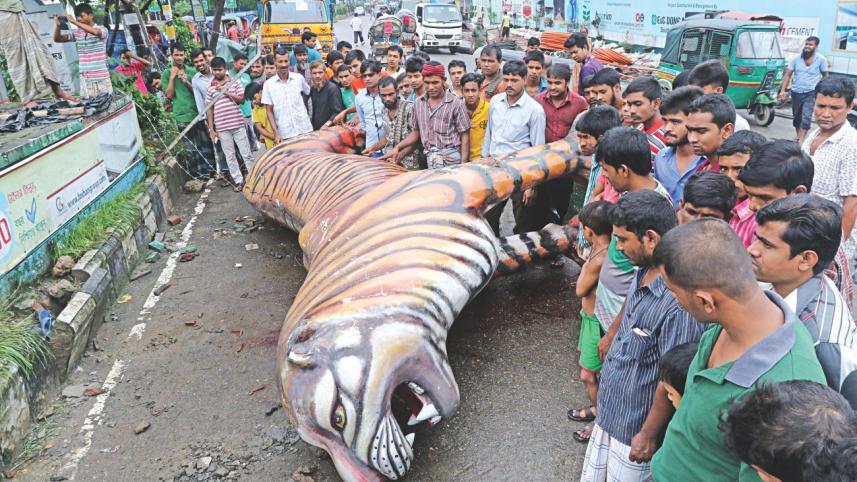The Beauty or the Beast?

Whenever we are on the streets of Dhaka, we live the tagline “expect the unexpected”. We come out on the streets with a number of possibilities - dealing with a significant amount of gridlock and congestion, inhaling smoke-filled air. A couple of times you could easily be stepping in a gooey mess piled up on the roadside. Expect getting mugged by crafty goons cutting the top of your CNG taxi. In the worst case, yet very possible scenario, your very life might be in danger by a bus being driven in full speed and on the wrong route.
But getting killed by a statue that aims to beautify the streets - how ironical does that sound?
The unfortunate death of 42-year old Md Ali when a tiger sculpture fell on him at Karwan Bazar made breaking news on TV channels and newspapers. The sculpture, like many others throughout the city, were made as part of a beautification project by the Dhaka South City Corporation and an advertising firm, in the name of a ‘facelift of the city’, just before the World Cup Tournament back in 2011.
Even though we call it a 'beautification measure', the sight of these aesthetically unpleasant sculptures jars the sensibility of city dwellers, and not to mention, art lovers. By putting up a few disproportionate animals in the heart of the city, nothing is being proven or portrayed, apart from a wrong perception of urbanisation and our sensibility as a whole, comments Architect Iqbal Habib.

Ideally Dhaka City Corporation is responsible for undertaking beautification projects while involving a team of landscape designers, architects, contractors and maintenance personnel.
“Instead of doing that, agencies with zero aesthetic sense are given the responsibility of these so called beautification projects. These agencies are fulfilling this responsibility from a more commercial perspective, by using substandard materials and adopting shortcuts without considering the artistic value of the structures,” Habib says in disappointment.
At some point, toilet tiles too were used to beautify the road dividers reflecting a bad taste of the nation to the outer world, until architects and city planners intervened and demanded that they be removed.
Not only do these projects fail to give an aesthetic impression, after the recent accident, questions can be raised about their safety, security and sustainability. According to locals and experts, such a heavy sculpture, made of concrete, was placed on a simple platform in an unplanned way, resulting in its collapse. Even the police officer-in-charge did not hesitate to blame the rain water for weakening the base of the structure as one reason that led to the collapse.
Speaking of the engineering aspect of the project, experts believe that in most cases, the workers had to face a hard time in meeting the deadline. “The last minute rush of getting such a big job done in time results in shortcuts and superficial construction that only manages to give a low quality, short-term creation,” comments Habib.
Roadway beautification should not only be confined to setting up some hurriedly made ugly statues and lighting up the streets, it should mean much more. It should combine a diverse palette of plant materials, architectural features using the best construction techniques to meet functional, aesthetic and environmental requirements and sculptures that represent our culture and create a sense of place.
Again, city planners believe that in a developing country like ours, the Dhaka City Corporations should take sustainable plans ahead of any big event, so that the huge fund that is solely allocated for this purpose is used in an effective manner.
“When we think of investing such a big amount of money, we should focus on establishing a few permanent, aesthetically pleasing sculptures instead of having a large number of temporary, disproportionate and aesthetically questionable sculptures,” suggests Habib.
While the streets of this city already pose tremendous trouble for dwellers, to many people proper beautification of the streets would seem like a bit too much to ask. But how can we forget the tales of old timers who claim Dhaka to once be a sight to behold? The government must make a sincere effort to retain whatever existing greenery we have in this city, while putting up more aesthetically pleasant structures.



 For all latest news, follow The Daily Star's Google News channel.
For all latest news, follow The Daily Star's Google News channel.
Comments